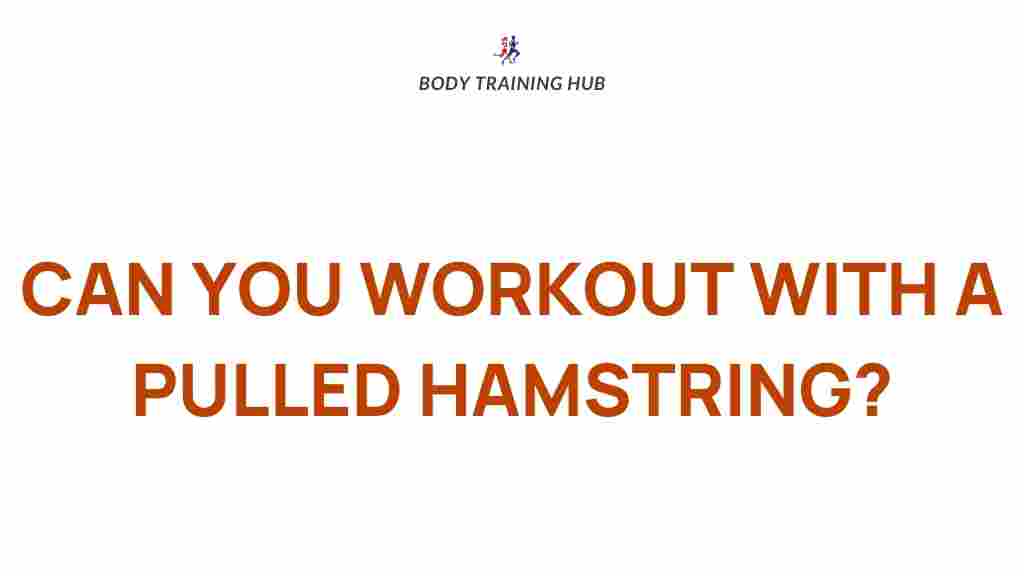Unleashing Your Potential: Overcoming a Pulled Hamstring
Experiencing a pulled hamstring can be a frustrating setback for anyone who is passionate about fitness and maintaining an active lifestyle. As one of the most common workout injuries, a pulled hamstring can hinder your ability to perform exercises that you enjoy. However, with the right approach to rehabilitation and recovery, you can overcome this injury and return to your fitness routines stronger than ever. In this article, we’ll explore the causes of a pulled hamstring, effective recovery exercises, and tips for preventing future injuries.
Understanding Pulled Hamstring Injuries
A pulled hamstring, or hamstring strain, occurs when the muscle fibers in the hamstring group become overstretched or torn. This common muscle strain can vary in severity, ranging from mild discomfort to a complete tear of the muscle. The hamstrings are a group of three muscles located at the back of your thigh, and they play a crucial role in movement and stability.
Causes of Pulled Hamstrings
Pulled hamstrings can result from various factors, including:
- Sudden movements or changes in direction
- Improper warm-up or stretching before physical activity
- Weakness or imbalances in the muscles
- Overexertion during workouts
- Fatigue from prolonged physical activity
Steps to Aid Recovery from a Pulled Hamstring
Recovering from a pulled hamstring involves a strategic approach that includes rest, rehabilitation, and gradual return to fitness routines. Here’s a step-by-step guide to help you heal effectively.
Step 1: Rest and Initial Care
Immediately after sustaining a pulled hamstring, it’s essential to follow the R.I.C.E. method:
- Rest: Avoid activities that cause pain or discomfort.
- Ice: Apply ice packs to the affected area for 20 minutes every 1-2 hours to reduce swelling.
- Compression: Use an elastic bandage or compression wrap to minimize swelling.
- Elevation: Keep the injured leg elevated above heart level to help reduce swelling.
Step 2: Consult a Healthcare Professional
It’s wise to consult a healthcare professional for an accurate diagnosis and to rule out more severe injuries. They can assess the severity of your pulled hamstring and provide guidance on appropriate treatment options.
Step 3: Gradual Rehabilitation Exercises
Once the acute pain has subsided, and you have received medical advice, you can begin rehabilitation exercises. These exercises should be performed gently to avoid re-injury:
- Gentle Stretching: Start with light stretches to improve flexibility, like seated hamstring stretches or standing toe touches.
- Strengthening Exercises: Gradually incorporate strengthening exercises, such as:
- Bridges
- Hamstring curls (with light weights)
- Bodyweight squats
- Range of Motion Exercises: Include movements that promote mobility, such as leg swings and ankle pumps.
Step 4: Return to Fitness Routines
As you recover, you can slowly reintroduce your regular fitness routines. However, it’s crucial to:
- Start with low-impact activities (e.g., swimming, cycling) before progressing to high-impact exercises.
- Listen to your body and stop if you experience pain.
- Incorporate a proper warm-up and cool-down in your workouts to prevent future injuries.
Troubleshooting Tips for Pulled Hamstring Recovery
Sometimes recovery from a pulled hamstring may not go as planned. Here are some troubleshooting tips to help you stay on track:
1. Monitor Your Pain Level
Keep a journal of your pain levels and activities. If you notice increased pain during certain exercises, modify or skip them until you’re ready to try again.
2. Adjust Your Nutrition
A well-balanced diet can aid recovery. Focus on:
- Protein-rich foods to support muscle repair.
- Fruits and vegetables for vitamins and antioxidants.
- Staying hydrated to maintain muscle function.
3. Use Appropriate Footwear
Wearing the right footwear can significantly impact your recovery. Ensure your shoes provide proper support and cushioning to reduce strain on your hamstrings.
4. Consider Physical Therapy
If your recovery stalls, consider seeking help from a physical therapist. They can provide specialized exercises and techniques tailored to your needs. For more information on physical therapy approaches, check out this resource.
Preventing Future Pulled Hamstrings
Understanding how to prevent future workout injuries is crucial for long-term fitness success. Here are some preventive measures:
- Warm-up Properly: Always engage in a dynamic warm-up before workouts to prepare your muscles.
- Strengthen Your Hamstrings: Incorporate regular strength training for your hamstrings and surrounding muscles.
- Stay Flexible: Regularly stretch your hamstrings and other leg muscles to maintain flexibility.
- Cross-train: Avoid repetitive strain by mixing different types of workouts (e.g., swimming, cycling, running).
Conclusion
Overcoming a pulled hamstring requires patience, dedication, and the right approach to rehabilitation. By following the steps outlined in this article, you can effectively recover from your injury and return to your favorite fitness routines. Remember to listen to your body, seek professional advice when necessary, and prioritize injury prevention strategies. With time and effort, you can unleash your full potential and continue your fitness journey.
For more tips on injury recovery and fitness, check out our other articles here!
This article is in the category Strength & Recovery and created by BodyTraining Team
